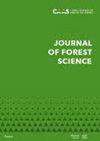Afforestation of agricultural land affects soil structural stability and related preconditions to resist drought
IF 1.1
Q3 FORESTRY
引用次数: 0
Abstract
Afforestation is important for the EU forest management strategy. Afforestation of abandoned and marginal arable land is a favourable non-agricultural land use option for climate change mitigation. It may prevent threats of drought or erosion e.g. by affecting the water balance in soil via increased structural stability. The structural stability control in afforested soil is related to i.a. organic matter content, nutrient content, soil reaction, planted tree species prosperity, and amelioration. A four-year field small-plot experiment on afforestation was carried out with Chernozem covered with deciduous (oak), coniferous (pine) or mixed planting, amended with 3 doses (no-application, 0.5 kg×m–2, and 1.5 kg×m–2) of alginite. In 2013 and 2016, soil reaction pHH2O, mean weight diameter (MWD), organic matter content (LOI) and total organic carbon (TOC) were determined and related to the soil structural stability to evaluate the soil precondition to sustain drought twice per vegetation period (spring and autumn). Afforestation significantly improved MWD compared to the field soil between 2013 and 2016 from 1.63 ± 0.04 mm to 1.85 ± 0.05 mm. Tree planting significantly neutralized the soil pHH2O, mixed planting appeared to improve LOI and TOC. Four-year afforestation led also to higher structural stability, less alkaline pH and deciduous tree-related increase in LOI, which may indicate better soil sustainability to drought.农用地造林影响土壤结构稳定性及抗旱的相关前提条件
植树造林是欧盟森林管理战略的重要内容。对废弃耕地和边际耕地进行造林是缓解气候变化的一个有利的非农业用地选择。它可以防止干旱或侵蚀的威胁,例如通过增加结构稳定性来影响土壤中的水分平衡。造林土壤的结构稳定性控制与有机质含量、养分含量、土壤反应、种植树种繁荣和改良有关。在黑钙土上覆盖落叶(栎)、针叶(松)或混作,外加3剂(不施用、0.5 kg×m-2和1.5 kg×m-2)褐藻酸盐,进行了为期4年的田间小块造林试验。2013年和2016年通过测定土壤反应pHH2O、平均重径(MWD)、有机质含量(LOI)和总有机碳(TOC)与土壤结构稳定性的关系,评价土壤在每个植被期(春季和秋季)两次持续干旱的前提条件。与2013 - 2016年的田间土壤相比,造林显著改善了MWD,从1.63±0.04 mm增加到1.85±0.05 mm。植树造林能显著中和土壤pHH2O,混播能显著提高土壤LOI和TOC。4年造林后土壤结构稳定性提高,碱性pH值降低,与落叶树相关的LOI增加,这可能表明土壤对干旱的可持续性更好。
本文章由计算机程序翻译,如有差异,请以英文原文为准。
求助全文
约1分钟内获得全文
求助全文
来源期刊

Journal of forest science
Forestry-
CiteScore
2.30
自引率
9.10%
发文量
48
审稿时长
6 weeks
期刊介绍:
Original results of basic and applied research from all fields of forestry related to European forest ecosystems and their functions including those in the landscape and wood production chain are published in original scientific papers, short communications and review articles. Papers are published in English
 求助内容:
求助内容: 应助结果提醒方式:
应助结果提醒方式:


